I have the following R dataset where the X axis are UNIX Epoch seconds and I am trying to plot it using the following code:
print("PLOT DATA")
print(dataset[1:10,])
plot(dataset[,"timestamp"], dataset[,"close"], cex=0, xlab="", ylab="")
lines(dataset[,"timestamp"], dataset[,"close"], xlab="", ylab="")
title(main="AAPL 2005-2010 DAILY CLOSE PRICES", xlab="Year", ylab="Price")
Which generates:
[1] "PLOT DATA"
timestamp open high low close volume
1 1104814800 1.1393 1.1691 1.1245 1.1418 1097193328
2 1104901200 1.1491 1.1652 1.1438 1.1518 680729056
3 1104987600 1.1551 1.1591 1.1309 1.1527 704141984
4 1105074000 1.1607 1.2434 1.1563 1.2366 2234953728
5 1105333200 1.2482 1.2625 1.2122 1.2315 1735512240
6 1105419600 1.2190 1.2348 1.1454 1.1529 2614860808
7 1105506000 1.1670 1.1768 1.1304 1.1690 2028471312
8 1105592400 1.3152 1.3290 1.2452 1.2465 3168234216
9 1105678800 1.2536 1.2807 1.2356 1.2536 1757210000
10 1106024400 1.2454 1.2625 1.2359 1.2616 1005413024
And I get:
How can I make the xticks in the plot display the year YYYY or month-year MM-YY instead of the UNIX Epoch seconds values?
Data
dataset <- structure(list(timestamp = c(1104814800L, 1104901200L, 1104987600L, 1105074000L, 1105333200L, 1105419600L, 1105506000L, 1105592400L, 1105678800L, 1106024400L), open = c(1.1393, 1.1491, 1.1551, 1.1607, 1.2482, 1.219, 1.167, 1.3152, 1.2536, 1.2454), high = c(1.1691, 1.1652, 1.1591, 1.2434, 1.2625, 1.2348, 1.1768, 1.329, 1.2807, 1.2625), low = c(1.1245, 1.1438, 1.1309, 1.1563, 1.2122, 1.1454, 1.1304, 1.2452, 1.2356, 1.2359), close = c(1.1418, 1.1518, 1.1527, 1.2366, 1.2315, 1.1529, 1.169, 1.2465, 1.2536, 1.2616), volume = c(1097193328, 680729056, 704141984, 2234953728, 1735512240, 2614860808, 2028471312, 3168234216, 1757210000, 1005413024)), class = "data.frame", row.names = c("1", "2", "3", "4", "5", "6", "7", "8", "9", "10"))
